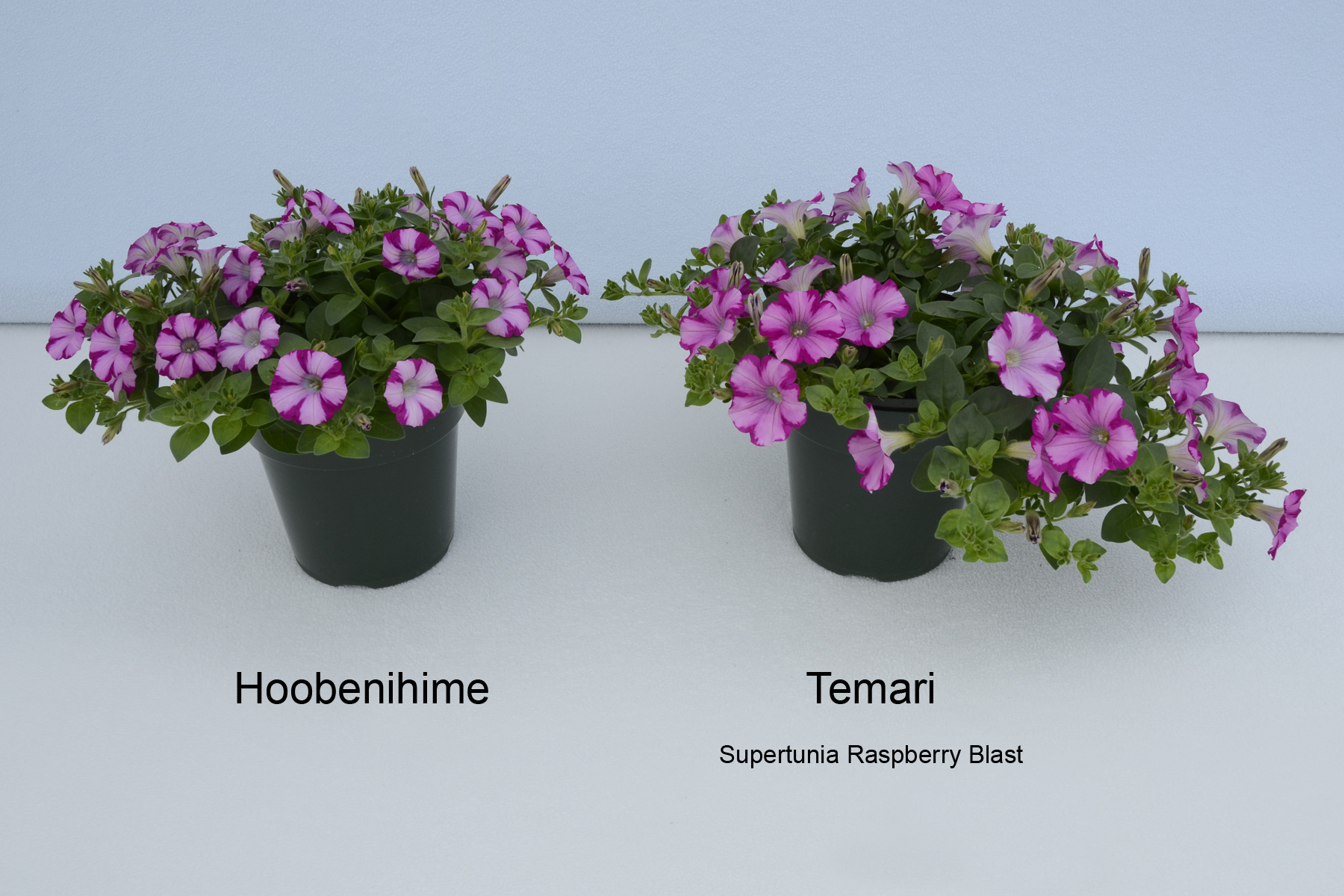Hoobenihime
| Denomination: | 'Hoobenihime' |
|---|---|
| Botanical Name: | Petunia ×hybrida |
| Applicant/Holder: |
Goto, Koji 730-3-2-101 Endo Kanagawa Prefecture Fujisawa City Japan Goto, Susumu 151 Okada, Samukawa Kanagawa Prefecture Koza Japan Goto, Fusako 730-3-2-101, Endo Kanagawa Prefecture Fujisawa City Japan |
| Breeder: |
Fusako Goto, Fujisawa City, Japan Koji Goto, Fujisawa City, Japan Susumu Goto, Koza, Japan |
| Agent in Canada: |
BioFlora Inc. 38723 Fingal Line R.R. #1 St. Thomas, Ontario N5P 3S5 Canada Tel: 519-317-7511 |
| Application Date: | 2012-01-30 |
| Application Number: | 12-7490 |
| Grant of Rights Date: | 2013-06-19 |
| Certificate Number: | 4541 |
| Date rights surrendered: | 2018-06-19 |
Variety Description
Variety used for comparison: 'Temari' (Supertunia Raspberry Blast)
Summary: The leaves and flowers of 'Hoobenihime' are smaller than those of 'Temari'. The upper side of the newly opened corolla of 'Hoobenihime' is darker purple along the margin than that of 'Temari'.
Description:
PLANT: semi-upright to creeping growth habit, medium to thick shoots
LEAF BLADE: ovate and elliptic, broad acute apex, no variegation, medium green on upper side
SEPAL: linear and oblanceolate, no anthocyanin colouration
FLOWER: single, funnelform, yellow veins
COROLLA LOBE: two colours on upper side, upper side is blue pink (RHS N74D) with purple (RHS 71A-B) at margin when newly opened, upper side is violet (RHS 75B) and blue pink (RHS N74D) with purple (RHS N74A) at margin on upper side when fully opened, weak conspicuousness of veins on upper side, weak undulation of margin
COROLLA TUBE: light blue violet (RHS 76D) on inner side, medium conspicuousness of grey (RHS 197B) veins on inner side
ANTHER: yellowish white before dehiscence
Origin & Breeding History: 'Hoobenihime' originated as a whole plant mutation of the petunia breeding line 'Usubenihime' discovered in May 2007 in Kanagawa, Japan. The new variety was selected based on flower colour and flower size. From November 2007 through 2008, the selected plant was vegetatively propagated from cuttings and trialed repeatedly to assess uniformity. In April 2009, the selection was confirmed to reproduce true to type in successive generations of asexual propagation and was subsequently named 'Hoobenihime'.
Tests & Trials: Trials for 'Hoobenihime' were conducted in a polyhouse during the spring of 2012 at BioFlora in St. Thomas, Ontario. The trial included 20 plants each of the candidate and reference varieties. All plants were grown from rooted cuttings and transplanted into 15 cm pots on April 25, 2012. Observations and measurements were taken from 10 plants of each variety on May 25, 2012. All colour determinations were made using the 2007 Royal Horticultural Society (RHS) Colour Chart.
Comparison tables for 'Hoobenihime' with reference variety 'Temari'
Leaf length (cm)
| 'Hoobenihime' | 'Temari' | |
|---|---|---|
| mean | 2.8 | 4.0 |
| std. deviation | 0.37 | 0.36 |
Leaf width (cm)
| 'Hoobenihime' | 'Temari' | |
|---|---|---|
| mean | 2.2 | 3.0 |
| std. deviation | 0.23 | 0.23 |
Flower diameter (cm)
| 'Hoobenihime' | 'Temari' | |
|---|---|---|
| mean | 3.9 | 5.6 |
| std. deviation | 0.11 | 0.18 |
Secondary colour of newly opened corolla (RHS)
| 'Hoobenihime' | 'Temari' | |
|---|---|---|
| upper side | brighter than 71A-B | darker than N74A |
Click on image for larger view

Petunia: 'Hoobenihime' (left) with reference variety 'Temari' (right)
Click on image for larger view

Petunia: 'Hoobenihime' (left) with reference variety 'Temari' (right)
Click on image for larger view

Petunia: 'Hoobenihime' (left) with reference variety 'Temari' (right)
- Date modified: